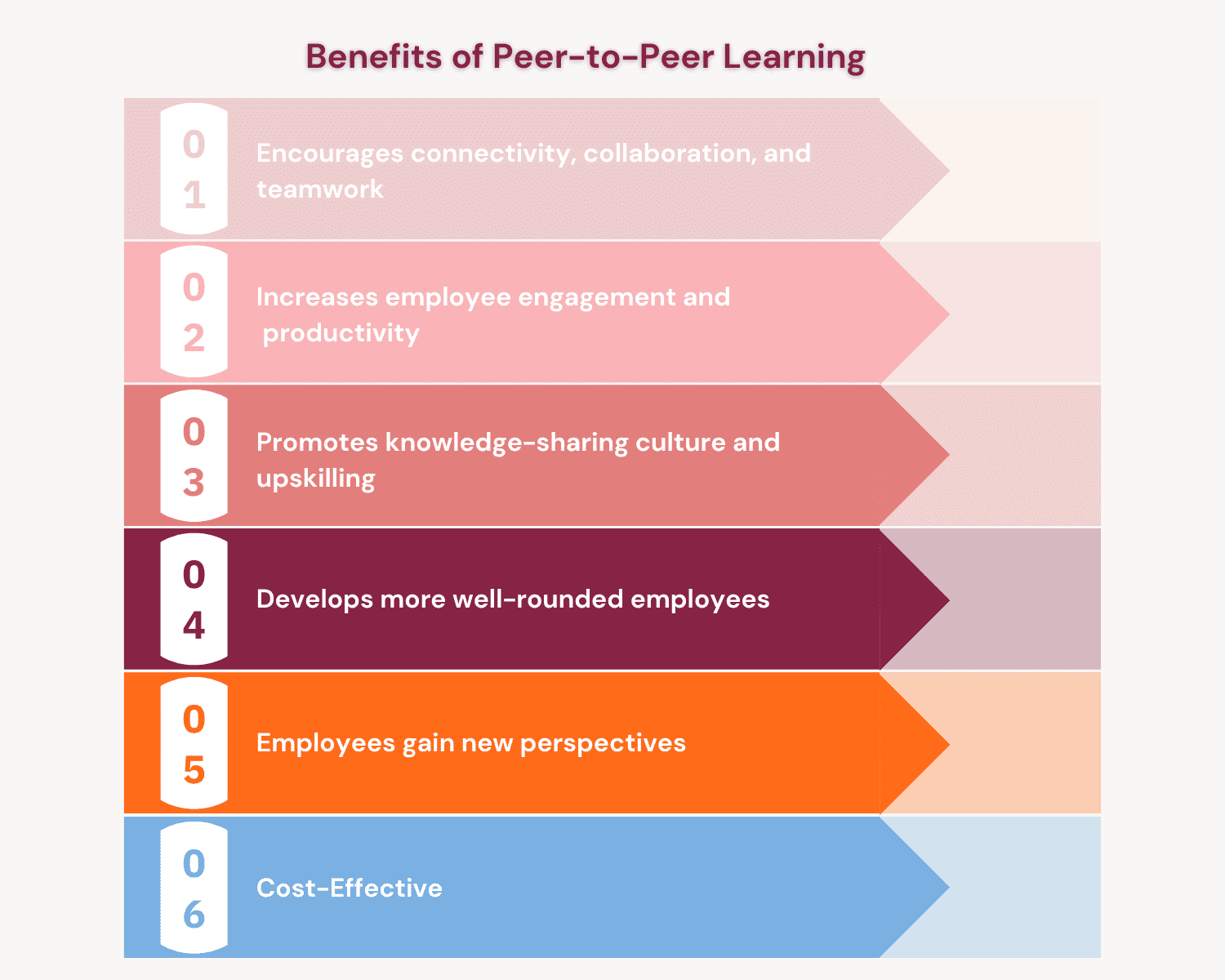What Is Peer-to-Peer Learning in the Workplace? (+Examples)
- September 14, 2022


Learning and development is constantly evolving, and it can be challenging to determine which trends are ideal for your organization.
Microlearning, gamification, spaced repetition, and mobile learning are a few of the learning and development trends that are centered on delivering outstanding results in terms of employee engagement and learning retention.
Another L&D trend gaining traction is peer-to-peer learning.
But what is peer-to-peer learning? How can it benefit your company’s learning programs? Is it worth investing in? How can it be implemented? We’ll explore the answers to these questions – and more – in this article.
What Is Peer-to-Peer Learning?
Peer-to-peer learning is a mutual learning and training strategy that involves participants of the same level engaging in collaborative learning. Simply put, peer-to-peer learning is when one or more learners teach other learners.
This type of learning allows employees to work through new concepts and share ideas with their peers working on the same project. The opportunity to teach and be taught by one another is an effective way for organizations to grow stronger employees that work together productively.
The Differences in Peer-to-Peer Learning in the Classroom vs. the Workplace
Peer learning encourages cooperation and social skills in students and helps them acquire knowledge by actively supporting other students. Rather than listening to the teacher’s instructions, peer learning enables students to educate their peers through group activities and help each other understand the curriculum better.
Peer learning in classrooms can be implemented by asking older students to teach younger students, incorporating a buddy system, or asking students to form groups and create a presentation to lecture on a specific topic.
Peer learning isn’t just for students in a classroom. Colleagues at work can also learn from each other through a similar approach.
According to an HBR survey, over half of employees look to their peers for learning opportunities and solving problems. Encouraging employees to share knowledge improves the skill set of your teams, cultivates a collaborative work environment, and encourages social connections among peers.
Cultivating discussions in the form of debates and discussion groups, arranging lunch and learn activities, and building a digital space for sharing ideas are some of the productive ways an organization can encourage peer-to-peer learning.
Examples of Peer-to-Peer Learning in the Workplace
Here are seven types of peer-to-peer learning examples commonly found in a corporate setting.
1. Action learning groups
Action learning groups are small groups of 5-7 people. They are peers at a similar level of responsibility and experience, usually working on solving complex problems that may appear complex or unsolvable. Action learning is a process of insightful questioning, reflective listening, generating new actions, and learning from a shared group.
While action learning focuses on teamwork, it also encourages workplace autonomy. Each team member is expected to contribute to the group, coming up with their own solutions. This helps build teams made of insightful and productive employees with good problem-solving and leadership skills.
2. Debates
A debate is a formal activity where a participant has a particular point of view and attempts to convince others having a different point of view to agree with the participant’s specific point of view. Debates encourage higher-order and critical thinking skills amongst all involved members.
Although debates are not always focused on generating new actions and learning, the members often implicitly learn a great deal about other points of view than their own.
3. Discussion groups
In discussion groups, employees share their insights and opinions to decide or enhance their understanding of a topic. Similar to debates, group discussions are also not focused on generating new actions and learning.
Discussion groups lead to a significant exchange of ideas among members, help research and formulate arguments, identify and rectify mistakes, generate thought-provoking questions, and solve problems.
4. Coaching
Peer coaching is a confidential, mutually beneficial relationship where two professional colleagues learn new concepts and share ideas, and solve work-related problems together. The peer coach can be a supervisor, mentor, or veteran employee in the same department. Since peers work on things together, peer coaching is not an exercise of advice or guidance but a give-and-take.
5. Peer mentor
In the case of peer mentoring, a senior or more experienced individual (the mentor) is assigned to act as an advisor, counselor, or guide to a junior or trainee. A beneficial mentoring relationship includes an intentional focus on new actions and learning. Unlike coaching, mentoring tends to be more informal, less structured, and on an as-need basis required by the mentee.
6. Lunch and learns
Also known as “brown bag” events, lunch and learns make for a popular trend in peer-to-peer learning. The concept is simple: everyone in a group, department, or company gets together on a specific day to have lunch. During lunch, either one person presents a topic of interest, or employees talk to their peers about work-related challenges.
In these learning sessions, employees aren’t just gaining new information; they’re interacting with their peers in a relaxed and social environment, making them less intimidated and more open to sharing ideas.
7. Peer performance reviews
Peer performance review is a process where peers offer their evaluations of a reviewee’s performance, skills, competencies, or attitude. The peer chosen for this process is a co-worker who regularly interacts with the reviewee. Peer reviews provide managers with a better picture of an employee’s true strengths, weaknesses, and hidden talents.
Benefits of Peer-to-Peer Learning In the Workplace
Here are a few benefits of implementing peer-to-peer learning in your workplace.

1. Encourages connectivity, collaboration, and teamwork
A peer-to-peer learning approach encourages connectivity, collaboration, and teamwork as peers are motivated to solve a problem or overcome a challenge together as a team.
2. Increases employee engagement and productivity
Employees feel more invested and engaged in the learning process by teaching others and sharing their own knowledge. Also, employees are more comfortable in peer learning situations than traditional training environments, where they might shy away from clarifying their doubts. Replacing an outsider with someone the audience immediately feels connected with engages the learner more.
3. Promotes knowledge-sharing culture and upskilling
Peer-to-peer learning promotes a knowledge-sharing culture through a collaborative setting where colleagues bounce concepts off each other, explore new ideas, and spur innovation – something every company should see value in. Many high-potential employees benefit from participating in peer-to-peer learning, as they can learn themselves while coaching others.
Furthermore, each participant in peer learning can also strengthen their skills and upskill themselves through the experience of sharing them with others.
4. Develops more well-rounded employees
As employees indulge in peer-to-peer learning activities, it helps boost their self-confidence, learning and listening skills and prepares future leaders by instilling leadership skills. It allows employees to see new perspectives in both learning styles as well as from other roles in the company. This leads to more well-rounded employees that know the inner workings of a company’s product, process, and various departments.
5. Employees gain new perspectives
Collaboration that happens in peer-to-peer learning exposes people to different perspectives and other people’s opinions, which is key to supporting diversity and fostering meaningful connections with others who may be different from themselves.
6. Cost-Effective
Peer-to-peer learning is an affordable option that requires less money than hiring instructors for exclusive workshops and training sessions. With peer learning, you can leverage the talent and skills you already have internally to cultivate employee development.

How to Implement Peer-to-Peer Learning in Your Organization
Here are a few tips for you to implement effective peer-to-peer learning in your organization.
1. Nominate a peer learning facilitator
Consider nominating a peer learning facilitator to run the peer-to-peer learning process smoothly. The responsibility of a facilitator is to stay neutral and keep the conversation flowing, and not be directly involved. There is no authority associated with their role.
2. Incorporate a buddy system
You can pair new hires with a more experienced colleague who acts as their buddy (or onboarding buddy) during onboarding. A buddy helps new employees integrate smoothly into the workplace and provides them with all the basic skills they need to get off to a good start. Moreover, it creates a positive and productive onboarding experience that cultivates social connections for new employees.
The responsibility of an onboarding buddy is to educate the new hire about the company’s day-to-day processes, introduce them to the team, help them build social connections, support their immediate productivity on the job, and help them build confidence and feel comfortable in the new work environment. This relationship is less formal, with its core purpose being encouragement and friendship.
3. Incentive peer-to-peer learning participation
Effective peer-to-peer learning ensures a personal commitment to the process and continuous engagement. Implementing an explicit incentive to enable participation and commitment to the process is helpful. This need not be financial and is probably most effective if it ties to the peer’s career progress. Peer learning initiatives that connect activities to actual work tend to be more sustained than others.
4. Invest in collaborative employee learning and training software
Strong communication and project management are essential for building an effective peer learning environment. Next-gen L&D platforms are perfect for enabling peer learning and distributing knowledge between employees throughout the company.
These platforms help build a shared learning culture by creating an atmosphere where team members continually collaborate and learn from one another, share expertise and build new skills.
Examples of L&D tools enterprises should invest in to empower their employee learning and development include:
5. Set up networking events
Setting up networking events can be a great source of generating new perspectives and ideas for everyone involved. For instance, setting up happy hour meetups, industry seminars, or office mixers helps build connections amongst colleagues and ultimately leads to a knowledge-sharing culture within the organization.
Peer-to-peer learning creates a collaborative environment amongst your workforce, where new employees learn from seasoned employees, and seasoned employees can further solidify their knowledge by teaching others.
With every peer learning session, your employees use the learning loop efficiently and break through the common barriers to learning and skill-building.
Peer-to-peer learning can be implemented via employee training software, resulting in higher learner engagement and a higher retention rate on average.
You can learn more about how Whatfix fosters a culture of learning and self-reliant support now!
Thank you for subscribing!


